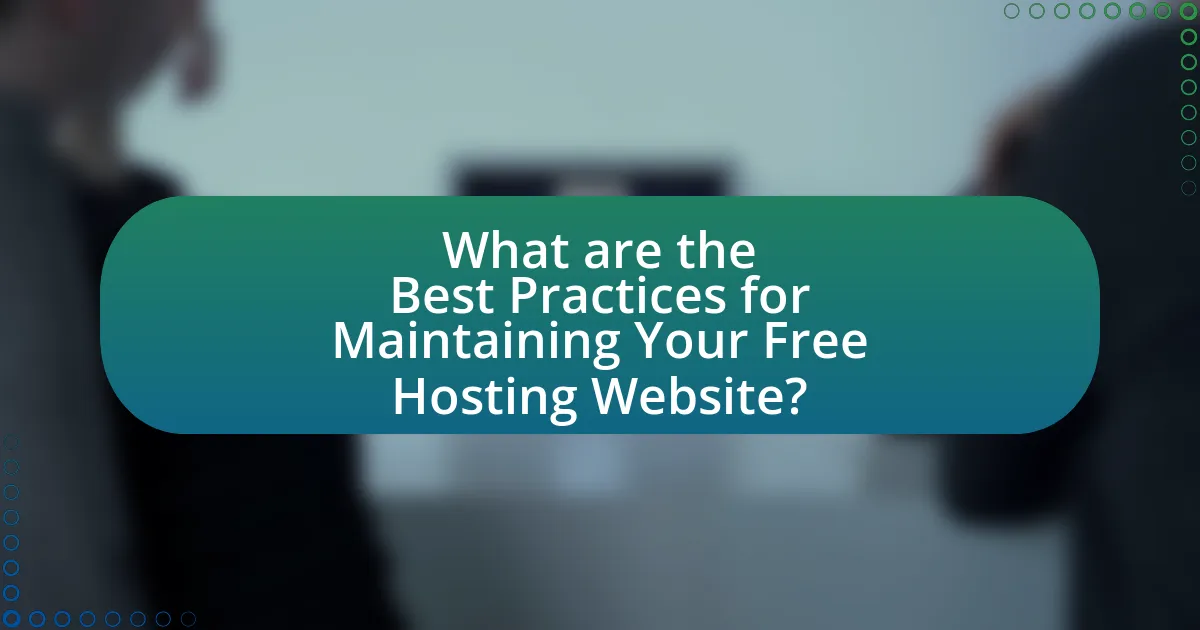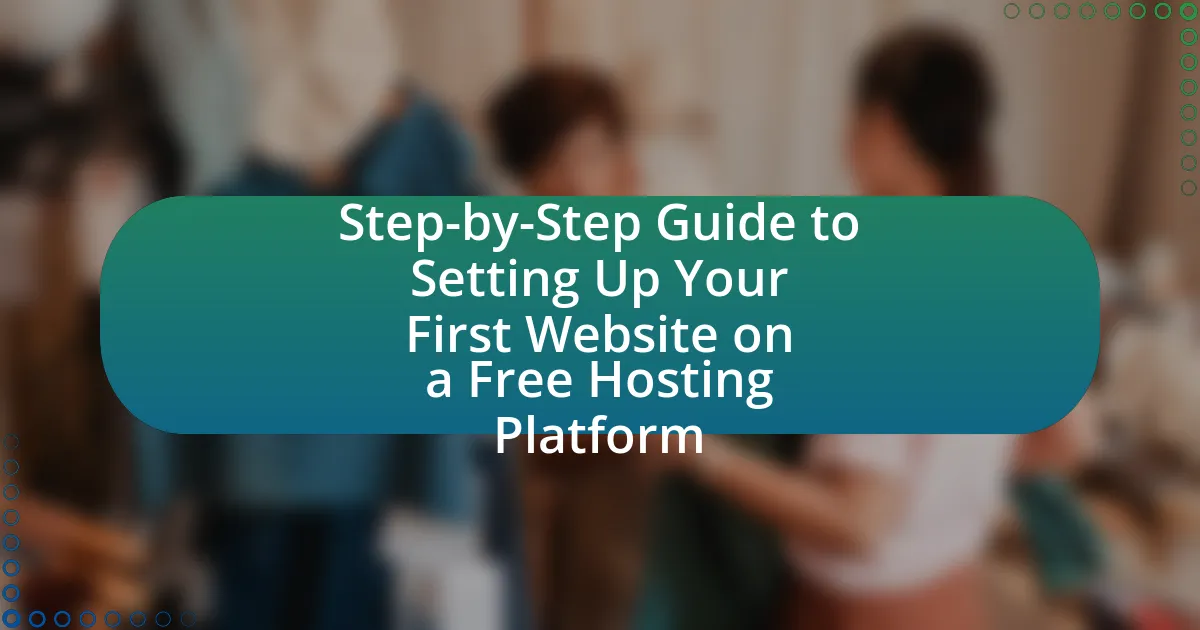Free web hosting for portfolio or resume websites provides individuals with the opportunity to create and publish their professional online presence without incurring costs. This article outlines the differences between free and paid hosting options, highlighting the limitations of free services, such as restricted storage and bandwidth, as well as the benefits for new users. It also discusses how to choose the right free hosting provider, the essential features to look for, and best practices for maintaining a website. Additionally, the article covers strategies for effectively showcasing skills and projects, optimizing website performance, and promoting online portfolios to enhance visibility and engagement.

What is Free Web Hosting for Portfolio or Resume Websites?
Free web hosting for portfolio or resume websites refers to online services that allow individuals to publish their personal or professional websites without incurring costs. These platforms typically offer basic features such as limited storage, bandwidth, and subdomain options, enabling users to showcase their work, skills, and experiences. Popular examples include GitHub Pages, WordPress.com, and Wix, which provide user-friendly interfaces and templates specifically designed for portfolio presentations. The availability of free web hosting is significant, as it democratizes access to online presence, allowing anyone to create a professional website without financial barriers.
How does free web hosting differ from paid hosting options?
Free web hosting differs from paid hosting options primarily in terms of features, reliability, and support. Free hosting typically offers limited storage, bandwidth, and lacks custom domain options, while paid hosting provides more resources, enhanced performance, and professional support. For instance, free hosting services often display ads on user sites, whereas paid services allow for ad-free experiences, which can enhance the professionalism of a portfolio or resume website. Additionally, paid hosting usually includes better security measures and customer support, ensuring that users can resolve issues quickly and maintain their websites effectively.
What are the limitations of free web hosting services?
Free web hosting services have several limitations, including restricted storage space, limited bandwidth, and lack of customer support. These services often impose caps on the amount of data you can store and transfer, which can hinder website performance and accessibility. Additionally, free hosting typically includes advertisements on your site, which can detract from your professional image. Security features are often minimal, increasing vulnerability to cyber threats. Furthermore, users may face restrictions on custom domain names, limiting branding opportunities. According to a 2021 survey by HostingAdvice, 70% of users reported dissatisfaction with the performance and reliability of free hosting options, underscoring these limitations.
How can free web hosting benefit new users?
Free web hosting can benefit new users by providing them with a cost-effective platform to establish their online presence without financial investment. This allows users to experiment with website creation, design, and content management, fostering learning and skill development. According to a survey by HostingAdvice, 70% of new website owners reported that free hosting helped them gain confidence in managing their sites before committing to paid services.
Why should you consider using free web hosting for your portfolio or resume?
Using free web hosting for your portfolio or resume can significantly reduce costs while providing a platform to showcase your skills and work. Many free web hosting services offer essential features such as customizable templates, easy-to-use interfaces, and basic analytics, which are beneficial for presenting your professional profile. Additionally, utilizing free hosting allows you to experiment with web design and content management without financial risk, making it an ideal choice for individuals starting their careers or those looking to enhance their online presence.
What advantages does free web hosting provide for showcasing work?
Free web hosting offers several advantages for showcasing work, primarily accessibility and cost-effectiveness. By eliminating hosting fees, individuals can create an online portfolio or resume without financial barriers, making it easier for emerging professionals to present their skills and projects. Additionally, free web hosting platforms often provide user-friendly interfaces and templates, enabling users to quickly set up and customize their sites without extensive technical knowledge. This ease of use encourages more individuals to share their work online, increasing visibility and potential networking opportunities. Furthermore, many free hosting services include built-in tools for analytics and SEO, which can enhance the discoverability of the showcased work.
How can free web hosting enhance your online presence?
Free web hosting can enhance your online presence by providing a cost-effective platform to showcase your portfolio or resume. This accessibility allows individuals and small businesses to establish an online identity without financial barriers, enabling them to reach a wider audience. According to a 2021 survey by Statista, 75% of users judge a company’s credibility based on its website design, highlighting the importance of having an online presence. By utilizing free web hosting, users can create professional-looking websites that improve visibility and attract potential employers or clients.

How to Choose the Right Free Web Hosting Service?
To choose the right free web hosting service, evaluate the features, reliability, and limitations of each option. Key factors include storage space, bandwidth, uptime guarantees, and customer support. For instance, services like InfinityFree offer unlimited storage and bandwidth, while others may impose strict limits. Additionally, consider the presence of ads, as some free hosts display advertisements on your site, which can detract from a professional appearance. Research user reviews and performance metrics to ensure the service meets your needs for a portfolio or resume website.
What features should you look for in a free web hosting provider?
When selecting a free web hosting provider, prioritize features such as storage capacity, bandwidth limits, uptime reliability, and customer support. Storage capacity should be sufficient to host your portfolio or resume content, typically at least 1 GB. Bandwidth limits must accommodate your expected traffic; many providers offer unlimited bandwidth, which is ideal. Uptime reliability is crucial, with a minimum of 99.9% uptime ensuring your site remains accessible. Lastly, responsive customer support is essential for resolving issues quickly, with options like live chat or email support being preferable. These features collectively enhance the functionality and reliability of your portfolio or resume website.
How important is storage and bandwidth in free hosting?
Storage and bandwidth are crucial in free hosting as they directly impact the performance and accessibility of a website. Limited storage can restrict the amount of content, such as images and files, that can be uploaded, while insufficient bandwidth can lead to slow loading times or downtime during high traffic periods. For instance, many free hosting services offer minimal storage, often around 1 GB, and bandwidth limits that can be as low as 5 GB per month, which may not suffice for a portfolio or resume website that aims to showcase multiple projects or attract significant visitor traffic. Therefore, understanding these limitations is essential for ensuring that the website functions effectively and meets user expectations.
What role do customer support and community forums play?
Customer support and community forums play a crucial role in enhancing user experience and resolving issues related to free web hosting for portfolio or resume websites. Customer support provides direct assistance to users facing technical difficulties, ensuring that they can effectively utilize the hosting services. Community forums, on the other hand, foster peer-to-peer interaction, allowing users to share experiences, solutions, and best practices, which can lead to quicker problem resolution and a sense of belonging among users. This collaborative environment can significantly improve user satisfaction and retention, as evidenced by studies showing that 70% of users prefer community-driven support for troubleshooting.
How do you evaluate the reliability of a free web hosting service?
To evaluate the reliability of a free web hosting service, assess its uptime, customer reviews, and support options. Uptime refers to the percentage of time the service is operational; a reliable service typically offers at least 99.9% uptime. Customer reviews provide insights into user experiences, highlighting issues such as downtime or poor support. Additionally, check the availability of customer support; reliable services often provide multiple channels for assistance, such as live chat or email. These factors collectively indicate the service’s reliability, ensuring that your portfolio or resume website remains accessible to visitors.
What indicators suggest a trustworthy free hosting provider?
Trustworthy free hosting providers typically exhibit several key indicators: reliable uptime, transparent terms of service, and positive user reviews. Reliable uptime, often above 99.9%, ensures that your website remains accessible, which is crucial for a portfolio or resume site. Transparent terms of service clarify any limitations or potential costs, preventing unexpected charges. Positive user reviews on independent platforms indicate user satisfaction and trustworthiness, as they reflect real experiences. Collectively, these indicators help assess the reliability and credibility of a free hosting provider.
How can user reviews influence your choice?
User reviews significantly influence your choice by providing insights into the experiences of others with a particular web hosting service. These reviews can highlight the reliability, speed, customer support, and overall user satisfaction of the hosting provider. For instance, a study by BrightLocal found that 91% of consumers read online reviews regularly, and 84% trust them as much as personal recommendations. This data underscores the impact of user feedback on decision-making, as potential users often rely on the collective experiences shared in reviews to assess the quality and suitability of free web hosting options for their portfolio or resume website.

How to Set Up Your Portfolio or Resume Website on Free Hosting?
To set up your portfolio or resume website on free hosting, first choose a reliable free hosting provider such as GitHub Pages, WordPress.com, or Wix. After selecting a provider, create an account and follow their setup instructions to establish your website. Most platforms offer templates specifically designed for portfolios or resumes, allowing you to customize your site easily. Once your site is set up, upload your content, including your resume, portfolio pieces, and any relevant information. Finally, publish your website and share the link to showcase your work. Free hosting services often have limitations, such as storage space and customization options, but they provide a cost-effective way to establish an online presence.
What steps are involved in registering for a free web hosting account?
To register for a free web hosting account, follow these steps: First, choose a reputable free web hosting provider, such as InfinityFree or 000webhost. Next, visit the provider’s website and locate the registration or sign-up section. Then, fill out the required information, which typically includes your email address, desired username, and password. After submitting your information, verify your email address if prompted. Finally, log in to your new account and follow any additional setup instructions provided by the hosting service. These steps ensure that you successfully create a free web hosting account for your portfolio or resume website.
How do you select a domain name for your portfolio or resume?
To select a domain name for your portfolio or resume, choose a name that reflects your personal brand and is easy to remember. A concise and relevant domain name enhances your online presence and makes it easier for potential employers or clients to find you. For instance, using your full name or a variation of it, such as johnsmithportfolio.com, can create a professional image. Additionally, keeping the domain name short, avoiding complex spellings, and using a .com extension can improve memorability and credibility. Research shows that 70% of users prefer .com domains, indicating their trustworthiness and familiarity.
What are the common pitfalls during the registration process?
Common pitfalls during the registration process include providing inaccurate information, overlooking terms of service, and failing to verify email addresses. Inaccurate information can lead to account verification issues, while overlooking terms of service may result in unexpected limitations or fees. Additionally, not verifying email addresses can prevent users from accessing their accounts, as many platforms require email confirmation to activate services. These pitfalls can hinder the overall experience of setting up a portfolio or resume website on free web hosting platforms.
How can you design your website effectively using free hosting tools?
To design your website effectively using free hosting tools, select a user-friendly platform that offers customizable templates and drag-and-drop features. Platforms like WordPress.com, Wix, and Weebly provide these functionalities, allowing users to create visually appealing websites without coding knowledge. Additionally, ensure that the chosen tool supports responsive design, which is crucial for mobile compatibility, as over 50% of web traffic comes from mobile devices. Utilizing built-in SEO tools offered by these platforms can also enhance your website’s visibility, making it easier for potential employers or clients to find your portfolio or resume online.
What website builders are compatible with free hosting services?
Website builders compatible with free hosting services include WordPress.com, Wix, Weebly, and Google Sites. These platforms allow users to create websites without incurring hosting fees, making them accessible for individuals looking to establish an online presence. For instance, WordPress.com offers a free plan that includes basic features and hosting, while Wix and Weebly provide drag-and-drop interfaces with free hosting options. Google Sites also allows users to create simple websites at no cost, integrating seamlessly with other Google services.
How can templates enhance the visual appeal of your site?
Templates enhance the visual appeal of your site by providing a cohesive and professional design that is visually engaging. They offer pre-designed layouts, color schemes, and typography that can significantly improve the aesthetic quality of a website, making it more attractive to visitors. Research indicates that websites with appealing designs can increase user engagement by up to 94%, as users are more likely to stay on a site that is visually pleasing. Additionally, templates ensure consistency across different pages, which helps in creating a unified brand identity, further enhancing the overall visual experience.
What content should you include on your portfolio or resume website?
A portfolio or resume website should include a clear introduction, a detailed resume, a portfolio of work samples, testimonials, and contact information. The introduction provides a brief overview of your professional background and objectives, while the resume section outlines your work experience, education, and skills in a structured format. The portfolio showcases your best work, demonstrating your capabilities and style, which is essential for attracting potential employers or clients. Testimonials from previous employers or clients add credibility and highlight your strengths. Finally, contact information ensures that interested parties can easily reach you for opportunities. Including these elements creates a comprehensive and professional online presence that effectively communicates your qualifications and expertise.
How do you showcase your skills and projects effectively?
To showcase your skills and projects effectively, create a well-structured online portfolio that highlights your best work. A portfolio should include detailed descriptions of each project, the skills utilized, and the impact of the work, allowing potential employers to understand your capabilities. According to a survey by the National Association of Colleges and Employers, 83% of employers prefer candidates who can demonstrate their skills through a portfolio. This statistic underscores the importance of presenting your work in a clear and accessible format, such as a personal website hosted on a free platform, which can enhance visibility and engagement with your projects.
What information is essential for a professional resume online?
A professional resume online must include personal contact information, a summary or objective statement, work experience, education, skills, and relevant certifications. Personal contact information ensures potential employers can reach the candidate, while a summary or objective statement provides a brief overview of the candidate’s career goals and qualifications. Work experience details the candidate’s employment history, showcasing relevant roles and achievements. Education outlines academic qualifications, and skills highlight specific competencies that align with job requirements. Relevant certifications demonstrate additional qualifications that may enhance the candidate’s appeal. These components collectively create a comprehensive and effective online resume that meets industry standards.

What are the Best Practices for Maintaining Your Free Hosting Website?
The best practices for maintaining your free hosting website include regularly updating content, optimizing for performance, ensuring security, and monitoring uptime. Regularly updating content keeps your website relevant and engaging, which can improve user experience and search engine rankings. Optimizing for performance involves compressing images and minimizing code to enhance loading speeds, as studies show that a one-second delay in page load time can lead to a 7% reduction in conversions. Ensuring security is crucial; using strong passwords and enabling HTTPS can protect your site from vulnerabilities. Monitoring uptime with tools can help you quickly address any downtime issues, as consistent availability is essential for user trust and engagement.
How can you optimize your website for better performance?
To optimize your website for better performance, implement techniques such as minimizing HTTP requests, optimizing images, and leveraging browser caching. Minimizing HTTP requests reduces the number of elements that need to load, which can significantly decrease load times; for instance, a study by Google found that reducing requests can improve load time by up to 50%. Optimizing images by compressing them without losing quality can also enhance performance, as unoptimized images can account for over 60% of a webpage’s total weight. Additionally, leveraging browser caching allows returning visitors to load your site faster by storing static resources locally, which can lead to a performance improvement of 80% for repeat visitors.
What techniques improve loading speed and user experience?
Techniques that improve loading speed and user experience include optimizing images, leveraging browser caching, and minimizing HTTP requests. Optimizing images reduces file sizes without sacrificing quality, which can decrease load times significantly; for instance, using formats like WebP can reduce image sizes by up to 30% compared to JPEG. Leveraging browser caching allows frequently accessed resources to be stored locally on a user’s device, which can lead to faster load times on subsequent visits. Minimizing HTTP requests by combining CSS and JavaScript files reduces the number of requests made to the server, which can enhance loading speed. According to Google, a one-second delay in mobile load times can reduce conversions by up to 20%, highlighting the importance of these techniques for user experience.
How does SEO play a role in your website’s visibility?
SEO significantly enhances your website’s visibility by optimizing its content and structure to rank higher in search engine results. When a website employs effective SEO strategies, such as keyword optimization, quality backlinks, and mobile-friendliness, it increases the likelihood of attracting organic traffic. According to a study by HubSpot, 75% of users never scroll past the first page of search results, highlighting the importance of ranking high for visibility. Therefore, implementing SEO best practices is crucial for ensuring that a portfolio or resume website reaches its target audience effectively.
What common issues might you face with free web hosting?
Common issues with free web hosting include limited storage and bandwidth, which can restrict website performance and accessibility. Many free hosting services impose strict limits on data transfer, leading to slow loading times or downtime during high traffic periods. Additionally, free web hosting often lacks customer support, making it difficult to resolve technical problems promptly. Security vulnerabilities are also prevalent, as free hosts may not provide adequate protection against cyber threats. Furthermore, advertisements may be displayed on your site, detracting from the professional appearance of a portfolio or resume website. These factors can significantly impact user experience and the overall effectiveness of the website.
How can you troubleshoot downtime or service interruptions?
To troubleshoot downtime or service interruptions, first check the server status and connectivity to identify if the issue is with the hosting provider. If the server is down, contact the hosting provider for updates and estimated resolution times. Next, review your website’s error logs to pinpoint specific issues, such as coding errors or resource overloads. Additionally, test your website from different devices and networks to rule out local connectivity problems. According to a study by the website monitoring service Pingdom, 98% of users will leave a site if it takes longer than 5 seconds to load, highlighting the importance of quick troubleshooting to minimize downtime.
What steps can you take to secure your website from threats?
To secure your website from threats, implement HTTPS, regularly update software, use strong passwords, and employ a web application firewall. HTTPS encrypts data between the user and the server, protecting sensitive information. Regular software updates patch vulnerabilities, reducing the risk of exploitation. Strong passwords prevent unauthorized access, while a web application firewall filters out malicious traffic, enhancing security. According to a 2021 report by Cybersecurity Ventures, cybercrime is projected to cost the world $10.5 trillion annually by 2025, highlighting the importance of these security measures.
What tips can help you maximize the benefits of free web hosting?
To maximize the benefits of free web hosting, choose a reliable provider that offers sufficient bandwidth and storage. Reliable providers, such as InfinityFree or 000webhost, ensure that your website remains accessible and performs well, which is crucial for showcasing your portfolio or resume. Additionally, utilize the available features, such as website builders and templates, to create a professional-looking site without needing extensive technical skills. This approach enhances user experience and engagement, which is vital for attracting potential employers or clients. Lastly, regularly update your content and optimize for search engines to improve visibility, as consistent updates signal to visitors that your portfolio is active and relevant.
How can you effectively promote your portfolio or resume website?
To effectively promote your portfolio or resume website, utilize social media platforms to share your work and engage with your audience. Social media channels like LinkedIn, Twitter, and Instagram can significantly increase visibility; for instance, LinkedIn reports that 92% of recruiters use the platform to find candidates. Additionally, optimizing your website for search engines through SEO techniques, such as using relevant keywords and meta tags, can enhance discoverability. According to a study by HubSpot, 75% of users never scroll past the first page of search results, emphasizing the importance of ranking high. Networking within professional communities and participating in forums related to your field can also drive traffic to your site, as personal recommendations often lead to increased interest.
What strategies can enhance user engagement on your site?
To enhance user engagement on your site, implement interactive content such as quizzes, polls, and comment sections. Interactive elements encourage users to participate actively, leading to increased time spent on the site and higher return visits. Research indicates that websites featuring interactive content can see engagement rates increase by up to 70%, as users are more likely to share their experiences and insights. Additionally, optimizing your site for mobile devices ensures accessibility, as over 50% of web traffic now comes from mobile users, further boosting engagement.




